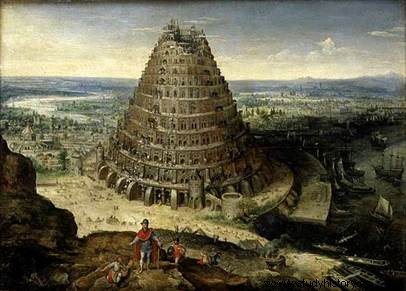 The Tower of Babel, major work of the Flemish painter Lucas van Valckenborch , is the symbol of the pride of man who claims to be able to do without God. This theme, borrowed from utopia and vanity, literally fascinated many artists of the 16th and 17th centuries. Valckenborch painted at least half a dozen of them (Munich, Koblenz, Mainz, etc.) under the decisive influence of Pieter Bruegel the Elder (Vienna version, 1563 and Rotterdam version, 1568).
The Tower of Babel, major work of the Flemish painter Lucas van Valckenborch , is the symbol of the pride of man who claims to be able to do without God. This theme, borrowed from utopia and vanity, literally fascinated many artists of the 16th and 17th centuries. Valckenborch painted at least half a dozen of them (Munich, Koblenz, Mainz, etc.) under the decisive influence of Pieter Bruegel the Elder (Vienna version, 1563 and Rotterdam version, 1568).
The Tower of Babel, the major work of Lucas van Valckenborch
Lucas van Valckenborch (born in 1535 in Louvain - buried on February 2, 1597 in Frankfurt am Main) was a Flemish landscape painter in the line of Pieter Bruegel the Elder. He is mainly interested in seasonal scenes, in which he represents the work of peasants but also market scenes. His paintings often give an impression of great precision and emerge from the imagination.
In Hebrew, Babel literally means "confusion". This is the key to this parable, both religious and moral in character, which highlights the dangers of claiming to be equal to God, and which questions us about the need for humanity to speak to one another, to make the effort to understand each other in order to carry out major projects. The biblical episode of the human dream of forcing the door of heaven and this humiliating divine punishment - the creation of languages - has inspired many artists over the centuries. Several medieval mosaics, manuscript illuminations, paintings and frescoes testify to this, including the Tower of Babel, a major work by the Flemish painter Lucas van Valckenborch.

In the foreground we can see Nimrod , the king who initiated the construction of the tower. Son of Astarte and grandson of Noah , he rebelled against God and managed to make his people believe that the city they will build will only serve to protect them against their enemies. A tower high enough for its top to reach the sky (at least as high as Mount Ararat, where Noah's Ark would have run aground), so that the waves could not submerge the top in the event of another Flood.
This work is on display at the Louvre Museum.
